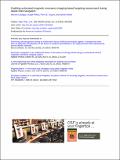| dc.contributor.author | Latulippe, Maxime | |
| dc.contributor.author | Felfoul, Ouajdi | |
| dc.contributor.author | Dupont, Pierre E | |
| dc.contributor.author | Martel, Sylvain | |
| dc.date.accessioned | 2017-09-12T20:31:24Z | |
| dc.date.issued | 2016 | |
| dc.identifier.citation | Latulippe, Maxime, Ouajdi Felfoul, Pierre E. Dupont, and Sylvain Martel. 2016. “Enabling Automated Magnetic Resonance Imaging-Based Targeting Assessment During Dipole Field Navigation.” Applied Physics Letters 108 (6) (February 8): 062403. doi:10.1063/1.4941925. | en_US |
| dc.identifier.issn | 0003-6951 | en_US |
| dc.identifier.uri | http://nrs.harvard.edu/urn-3:HUL.InstRepos:33884834 | |
| dc.description.abstract | The magnetic navigation of drugs in the vascular network promises to increase the efficacy and reduce the secondary toxicity of cancer treatments by targeting tumors directly. Recently, dipole field navigation (DFN) was proposed as the first method achieving both high field and high navigation gradient strengths for whole-body interventions in deep tissues. This is achieved by introducing large ferromagnetic cores around the patient inside a magnetic resonance imaging (MRI) scanner. However, doing so distorts the static field inside the scanner, which prevents imaging during the intervention. This limitation constrains DFN to open-loop navigation, thus exposing the risk of a harmful toxicity in case of a navigation failure. Here, we are interested in periodically assessing drug targeting efficiency using MRI even in the presence of a core. We demonstrate, using a clinical scanner, that it is in fact possible to acquire, in specific regions around a core, images of sufficient quality to perform this task. We show that the core can be moved inside the scanner to a position minimizing the distortion effect in the region of interest for imaging. Moving the core can be done automatically using the gradient coils of the scanner, which then also enables the core to be repositioned to perform navigation to additional targets. The feasibility and potential of the approach are validated in an in vitro experiment demonstrating navigation and assessment at two targets. | en_US |
| dc.language.iso | en_US | en_US |
| dc.publisher | AIP Publishing | en_US |
| dc.relation.isversionof | doi:10.1063/1.4941925 | en_US |
| dash.license | LAA | |
| dc.subject | Magnetic resonance imaging | en_US |
| dc.subject | Image scanners | en_US |
| dc.subject | Ferromagnetism | en_US |
| dc.subject | Medical image quality | en_US |
| dc.subject | Saturation moments | en_US |
| dc.title | Enabling automated magnetic resonance imaging-based targeting assessment during dipole field navigation | en_US |
| dc.type | Journal Article | en_US |
| dc.description.version | Version of Record | en_US |
| dc.relation.journal | Applied Physics Letters | en_US |
| dash.depositing.author | Dupont, Pierre E | |
| dc.date.available | 2017-09-12T20:31:24Z | |
| dc.identifier.doi | 10.1063/1.4941925 | * |
| dash.contributor.affiliated | Dupont, Pierre | |


